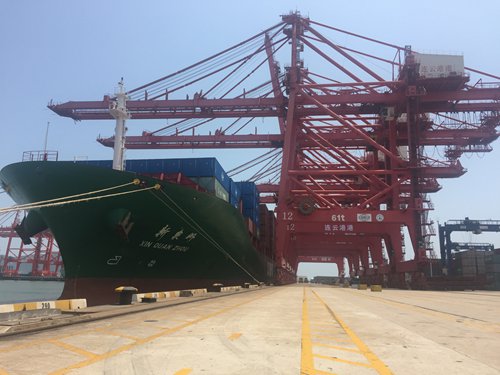
A ship at the Lianyungang Port in East China's Jiangsu Province Photo: Chu Daye/GT
The Lianyungang Port in East China's Jiangsu Province is an important link along the transcontinental New Eurasian Land Bridge that runs from the Pacific to Rotterdam, the Netherlands. As the China-proposed Belt and Road initiative has gained momentum in recent years, the port now faces new challenges from domestic and foreign rivals. Nevertheless, it has been developing new strategies to reassure its leading position as a vital connecting dot of trade alongside the Silk Road Economic Belt and the 21st-Century Maritime Silk Road.
In 1992, Lianyungang Port became the eastern end of a second overland rail link that traverses the Eurasia landmass. Over the years, it has become an experienced player in handling cross-border, multimode transport combining seaborne trade and rail traffic.
Since 1992, the port has been handling about half of all international multimode transport business and once reached an annual turnover record of 106,000 twenty-foot equivalent units (TEUs).
In 2016, the port handled 46,900 TEUs of cargoes used in international multimode transportation, positioning it at the top for China's seaport shipping.
Such results, however, do not merely appear without overseas synergy.
Challenges for the veteran
Zheng Ping, analyst of industry portal chineseport.cn, said that Lianyungang was once the Chinese pioneer of the New Eurasian Land Bridge, but as the Chinese railway network expanded, more domestic cities started to establish their own connectivity between the Pacific and Europe, and thus the port's status as a veteran became challenged.
In addition to the string of cities now choosing to gather their own cargoes to disperse across Asia from their newly established transport hubs, foreign rivals are also competing for a market share.
Wang Guijia, international marketing director of Lianyungang NewSilkRoad International Container Development, said part of the challenge comes from the reemergence of the Trans-Siberian Railway, which starts from Russia's Far East, passes through Siberia and finally reaches Central Asia. Wang's company is the logistics platform under the Lianyungang Port Group.
The two land bridges have roughly the same customers - Japan, South Korea and Southeast Asia - for the transportation of transit goods from the Pacific coast to Central Asia, which causes competition.
"A mix of factors, including the depreciation of the rubles and pricing mechanism, caused our Russian freight rival to become more competitive. Even though the route they offered is 2,700 kilometers longer than ours, they can offer cheaper rates. And they also enjoy the benefits of not needing to switch trains halfway between wide gauge and standard gauge railways," Wang told the Global Times on Thursday.
The wide gauge, used by former Soviet countries, is 85 millimeters wider than the China-used standard gauge.
"Our advantage of shorter delivery time is also undermined by Central Asian clients' less sensitive demand," Wang said.
Wang added that he and his colleagues could not sit back and watch the businesses created by their fathers' generation be snatched away by competitors without feeling ashamed.
Instead, Wang and his colleagues have been fighting hard to bring customers back, for example, by opening up new markets.
"Last August, we rolled out a new service linking Lianyungang to Almaty in Kazakhstan to Tashkent in Uzbekistan. So now, around 60-70 percent of the cargoes bound for Tashkent will embark on the trip from our port, as our port beats other venues in terms of cargo velocity and customs clearance efficiency," Wang noted.
In April, Uzbekistan also reportedly used the Lianyungang Port to export Uzbek-assembled cars to South Korea for the first time, combining the benefits of rail and sea transport.
"Now, each week, we send five trains to Tashkent, carrying a diversified cargo full of daily necessities, small home appliances and spare auto parts," Wang said.
Wang said eastbound goods are of great importance as they complete a logistics loop from China's coast to Central Asia, fix the issue of cargo flow imbalance and bring back containers.
Kazakh partnership
The port has also been cooperating with investors from Central Asian countries to co-build fortunes along the Silk Road Economic Belt. Kazakhstan is the first.
In 2014, the port authority set up a joint venture (JV) logistics company - Lianyungang China-Kazakhstan International Logistics Co - with KTZ Express, the logistics subsidiary of Kazakhstan Railways. The two sides hold a 51 percent stake and 49 percent stake, respectively. The JV is Kazakhstan's largest overseas investment project so far.
Amid turbulences in global trade, bilateral trade between China and Kazakhstan has been declining, with the total trade volume dropping from $23.98 billion in 2012 to $7.88 billion in 2016, data from the Ministry of Commerce showed.
The logistics center still managed to increase its container turnover by 106 percent year-on-year in the first five months of this year to 101,000 TEUs.
"The overall situation is not easy, for all of the trading nations. But we must still drive things ahead and boost bilateral trade. We plan to quadruple our business by 2020 from the level it was at in 2016," Iyembergenov Dinmukhamed, vice general manager at Lianyungang China-Kazakhstan International Logistics Co, told the Global Times.
On February 5, Kazakhstan exported 720 tons of wheat to Vietnam via the logistics JV at Lianyungang Port. The route opened up the Southeast Asia for Kazakh agricultural produce.
According to estimates by Kazakhstan authorities, trade between China and Europe via Kazakhstan will reach 800,000 TEUs by 2020.
Bilateral investment cooperation continued when on May 15, China COSCO Shipping Corporation and Jiangsu Lianyungang Port Co signed a contract with Kazakhstan Railways to buy 49 percent of an inland port located in the Khorgos-East Gate special economic zone near the China-Kazakhstan border. From the port at the border, railway cargoes can reach Lianyungang in five days and reach Europe in about 10 days.
Bigger role
Lianyungang is forging itself into a gateway to the sea for all the Central Asian countries that hold Shanghai Cooperation Organization (SCO) membership.
In November 2013, Chinese Premier, Li Keqiang, said at a meeting in Tashkent that China is willing to provide logistics and warehousing services for SCO member countries at Lianyungang Port.
The port has acted on this by planning a 45 square kilometer logistics park south of the port area. In addition to sea and rail access, the park will also have access to Yangtze River traffic, a perfect channel for many of the commodities in trade between Central Asian countries, such as minerals.
Wang Peng, vice director of the SCO (Lianyungang) International Logistics Park Administration Committee, told the Global Times that the logistics park will focus on diversifying the range of merchandise for Central Asian countries, for instance, by providing warehousing services for animal husbandry products from Central Asia.

